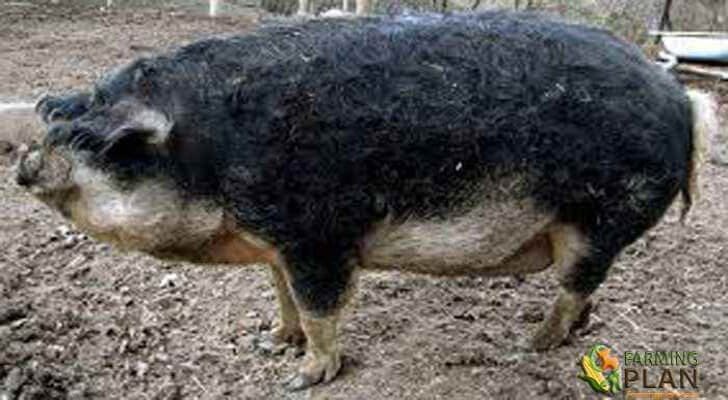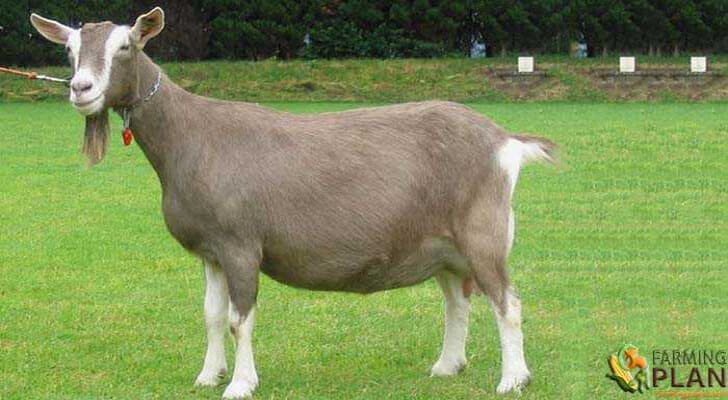Mangalitsa pig is a breed of domestic pig native to Hungary. It has its origins in the crosses of the primitive race Sumadia of the Mediterranean trunk (trunk to which the Iberian pig also belongs) with the races Szalontai and Bakonyi (typical semi-wild races of the Carpathians).
In Hungary, this race was bred for the table of the emperor of the Austro-Hungarian Empire at the beginning of the 20th century. After World War II, its number was drastically reduced, reaching the point of extinction. At the end of the 80, there were only about 200 copies distributed by some farms in Hungary.

Faced with its extinction because its fatty flesh was not demanded at that time, the German geneticist Peter Toth was interested in recovering the species. So he bought the pregnant females farm by farm, which saves the species whose meat is considered a delicacy and reaches high prices in the market.
Some 60,000 pigs of this breed are currently produced in Hungary and their breeding has been extended to Germany, Austria, and Switzerland. Precisely because every day it was more difficult to find fatty pigs for the manufacture of cured ham. You may also like to read Berkshire Pig.
Jamones Segovia is a Spanish company and currently the only company in the world that maintains the breeding and commercialization of the three varieties. This company was interested in this breed and decided to investigate it. Thus, starting in 1990, he began a program to recover it, getting 90 breeding females through advertisements in the Hungarian press.
Characteristics of Mangalitsa Pig
Depending on their color, four types of Mangalica pigs are distinguished. There are reddish, blond (to which 80% correspond), the swallow (a combination of black and white) and black (now extinct). The names mangalitza or mangalitsa are also used to refer to this breed. In the world, there are animal species that, although widely known in their place of origin, for outsiders are strange or unknown.
This is the case of the Mangalica pig, a porcine species with a peculiar little-known aspect. The first thing that catches the attention of this animal is its woolly fur, which resembles a sheep with a very short neck. This feature has earned them to be known as pigs.
This breed of pigs is characterized by having an abundant and shaggy coat during the winter season the rest of the year, they show blond and curly bristles. It has very thick and long hair that looks like wool in winter. But that changes in spring with curly bristles, clear and bright.
There is the only evidence of another swine breed with such long hair: the extinct Lincolnshire Curly-coat pig. The skin of the area of the eyes and the nasal disc shows a black pigmentation. You may also like to read Essex Pig.
The animals that do not present it are removed from the breeding. The color of your nails is also black. Mangalica pig has a very high proportion of fat in bacon. Their fatty meat makes them also ideal for the production of ham. The fact of not a desirable animal for direct consumption due to the amount of fat it produces its long fattening time and special care for its upbringing.
This caused farmers and ranchers to see Mangalia as an expense rather than an investment and decided to stop raising him. After decades of bonanza in the market of Mangalica, the population decreased. In such a way that at the beginning of 1990, there were only 198 specimens of this hairy pig.
It only has between five and eight pups per litter. Instead of twelve or fourteen like the rest of the common breeds. Your channel has half the meat and twice as much fat as a white pig. What causes meat and sausages produced with this breed to retain their properties for longer and their flavor is more concentrated? In addition, the meat of this species can mature longer.
Food
Mangalitsa pig feeding, which is raised on extensive farms, is based on cereals and pastures. You may also like to read Duroc Pig.
Usage
The Mangalitsa pig, outside Hungary, has only been trying to breed in the United States. Currently, about 25,000 Mangalica hams are sold in the markets of the U.S.A. and Japan. In these countries where they are highly appreciated by the best restaurateurs. While the hams, loin, and shoulders are exported, the rest stays in Hungary itself to make chorizo and salami. You may also like to read Hampshire Pig.
Special Features
Mangalitsa pig was in danger of extinction. It’s meat with an amount of fat greater than 70% of its body. What also happened to have caused it to be in danger of extinction?
Well, when scientists determined that the consumption of fats of animal origin was harmful to the human organism it stopped being an animal from which abundant fat was obtained for cooking, manufacturing, candles, cosmetics and even explosives and it became an animal without commercial value. They can also be the ideal pet they are playful like dogs.
FAQ
Are Mangalitsa pigs good to eat?
Mangalitsa pigs are a breed of pig that are known for their high-fat content and unique flavor. These pigs are prized for their marbled meat, which is often compared to the texture and taste of Wagyu beef. The fat content makes the pork especially juicy and flavorful when cooked, making it a great choice for roasting or barbecuing. While Mangalitsa pork can be enjoyed by all, it is especially popular among chefs who appreciate its unique flavor profile.
What does Mangalitsa pig taste like?
Mangalitsa pigs are known for their unique flavor and texture. The meat has a rich, buttery taste that is often compared to lamb or pork. It also has a distinctive marbling of fat that gives it a melt-in-your-mouth texture when cooked. Many chefs have described the flavor as being sweet and nutty, with notes of hazelnuts and honey.
What is most unique about a Mangalitsa pig?
Mangalitsa pigs are unique for several reasons. First, they have an incredibly thick coat of fur that can range from reddish-brown to black in color. This fur is very curly and woolly, making it look quite different from other breeds of pigs. Second, their meat is considered to be some of the most flavorful pork in the world due to its high-fat content and marbling. Finally, they are known for having a docile and friendly temperament, which makes them ideal for petting zoos or as companion animals. All in all, Mangalitsa pigs are truly one-of-a-kind!
Conclusion
Mangalica is a Hungarian breed of domestic pig. It was developed in the mid-19th century by crossbreeding Hungarian breeds from Nagyszalonta and Bakony with the European wild boar and the Serbian Šumadija breed. The Mangalica pig grows a thick, curly coat of hair. If you’ve found this article helpful in understanding more about this fascinating animal, please let us know! We always love to hear how our guides have helped people learn new things or understand better what they already knew. Good luck with your search for that perfect pet!
As A Reference: Wikipedia


